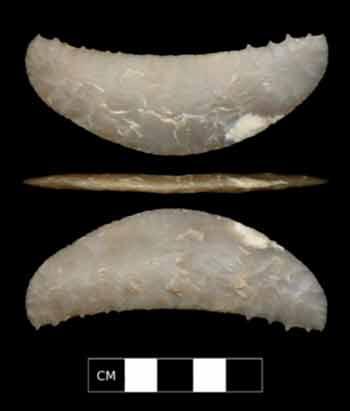Blake de Pastino
Source - http://westerndigs.org/11000-year-old-seafaring-indian-sites-discovered-on-california-island/

Modern members of the Chumash, who have inhabited the Channel Islands for thousands of years, re-create a crossing to the islands in a tomol canoe. (NPS)
Just offshore from the chock-a-block development of Southern California, archaeologists have discovered some of the oldest sites of human occupation on the Pacific Coast.
On Santa Rosa Island, one of the Channel Islands just 65 kilometers from Santa Barbara, nearly 20 sites have been found that reveal signs of prehistoric human activity, from massive middens of abalone shells to distinctive stone points and tool-making debris.
At least nine of the sites have what archaeologists say is “definitive evidence” of ancient Paleoindian occupation, about half of them having been dated to 11,000 to 12,000 years ago — making their inhabitants some of the earliest known settlers of North America’s West Coast.
“Finding these sites and the definitive evidence for early occupation is crucial and tells us that people were there, occupying the landscape at the end of the Pleistocene,” said Dr. Torben Rick of the Smithsonian Institution, who led the survey that uncovered the sites.
The discovery adds hefty new data to the already mounting evidence that maritime Paleoindians — also known as Paleocoastal peoples — lived along the California coast at the end of the last ice age.
Such finds have important implications for the history of human migration, suggesting that at least some of America’s earliest settlers moved south from Alaska along the coast, rather than farther inland, where retreating glaciers are thought to have allowed passage to the continent’s interior.

Distinctive crescent-shaped stone tools, like this from neighboring San Miguel Island, are among the Paleocoastal artifacts that have been identified. (University of Oregon)
Uncovering hard evidence of this coastal migration has proved challenging, however, because the shorelines that Paleocoastal people would have followed have long since been submerged by rising seas.
But in recent years, surveys of California’s modern-day coasts and islands have turned up several prehistoric sites that are still on dry land, farther inland from the now-submerged shores.
It was while studying some of these sites on San Miguel Island — another of the Channel Islands — that Rick and his colleagues made a key observation: They noted that Paleocoastal settlements tended to have certain traits in common that made them more suitable than sites right on the water.
The earliest sites tended to be 1 to 7 kilometers from where the shoreline used to be, for example, in elevated areas that offered commanding views of the coast and often the island’s interior. Optimal locations were also near sources of useful raw materials, like chert for making tools, as well as fresh water and rockshelters or caves for refuge.
With these factors in mind, Rick’s team turned to Santa Rosa Island to survey its previously unexplored southwestern coast.
The island was already famous as the home of Arlington Man, perhaps the oldest human remains ever found in North America, discovered in 1959 and dated to 13,000 years ago.
But the southwestern portion of the island had received little scientific attention, and it fit many of the criteria Rick’s team had identified. What’s more, it was the steepest part of the island, which meant it had been less susceptible to rising sea levels and more likely to still hold evidence of early sites.